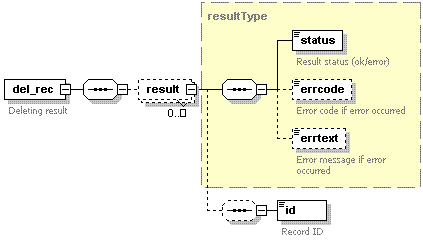Deleting DNS Records
Both zone template records and site or site alias zone records can be deleted using the del_rec operation. You can retrieve multiple records in a single del_rec operation using filtering rules. For more information about filters, refer to the Available Filters section.
Request Packet Structure
A request XML packet deleting a DNS record from Plesk database includes the get_rec operation node:
<packet>
<dns>
<del_rec>
...
</del_rec>
</dns>
</packet>
The graphical representation of the del_rec node is as follows:

Note: The interactive schema navigator for all request packets is available here: http://plesk.github.io/api-schemas/1.6.9.1/agent_input.svg.
- The filter node is required. It specifies the filtering rule.
For more information, refer to the Available Filters
section. Data type:
dnsSelectionFilterType (
dns_input.xsd) . - The template node is optional. If present, only DNS zone template records are available for deleting. In this case filter children cannot be specified as a filtering rule. Data type: none.
Note: If you leave the filter node blank (<filter/>) all records
(zone template records or zone records, depending on presence of the
template node in the request packet) will be removed.
You can delete multiple DNS records in a single packet. Add as many del_rec operations as the number of different filtering rules.
<dns>
<del_rec>
...
</del_rec>
...
<del_rec>
...
</del_rec>
</dns>
Note: When creating request packets, put nodes and elements in the order they follow in the packet structure.
Response Packet Structure
The del_rec node of the output XML packet is structured as follows:

Note: The interactive schema navigator for all response packets is available here: http://plesk.github.io/api-schemas/1.6.9.1/agent_output.svg.
- The result node is optional. It is required if the operation
del_rec succeeds and the data set retrieved from the server is
not empty. If the id was set as a filtering rule in the request
packet, the result node is also required. Data type:
resultType (
common.xsd). - The status node is required. It specifies the execution status of the del_rec operation. Data type: string. Allowed values: ok | error.
- The errcode node is optional. It is used to return the error code when the del_rec operation fails. Data type: unsignedInt.
- The errtext node is optional. It is used to return the error message if the del_rec operation fails. Data type: string.
- The id node is required if the del_rec operation has succeeded. If the id was set as a filtering rule in the request packet, the id node is also required. Returns the unique identifier of the DNS record. Data type: integer.
Deleting a single DNS record
This request packet deletes DNS record with ID 75.
<packet>
<dns>
<del_rec>
<filter>
<id>75</id>
</filter>
</del_rec>
</dns>
</packet>
Reponse:
<packet>
<dns>
<del_rec>
<result>
<status>ok</status>
<id>75</id>
</result>
</del_rec>
</dns>
</packet>
If the DNS record with ID 75 was not found on the server, the response from the server looks as follows:
<packet>
<dns>
<del_rec>
<result>
<status>error</status>
<errcode>1013</errcode>
<errtext>DNS record does not exist.</errtext>
<id>75</id>
</result>
</del_rec>
</dns>
</packet>
Deleting multiple DNS records
This request packet deletes DNS records for the site ID 7 and the record with ID 5.
<packet>
<dns>
<del_rec>
<filter>
<site-id>7</site-id>
</filter>
</del_rec>
<del_rec>
<filter>
<id>5</id>
</filter>
</del_rec>
</dns>
</packet>
Response (when three DNS records for the site alias were deleted, and the record with ID 5 was not found on the server):
<packet>
<dns>
<del_rec>
<result>
<status>ok</status>
<id>17</id>
</result>
<result>
<status>ok</status>
<id>18</id>
</result>
<result>
<status>ok</status>
<id>19</id>
</result>
</del_rec>
<del_rec/>
</dns>
</packet>